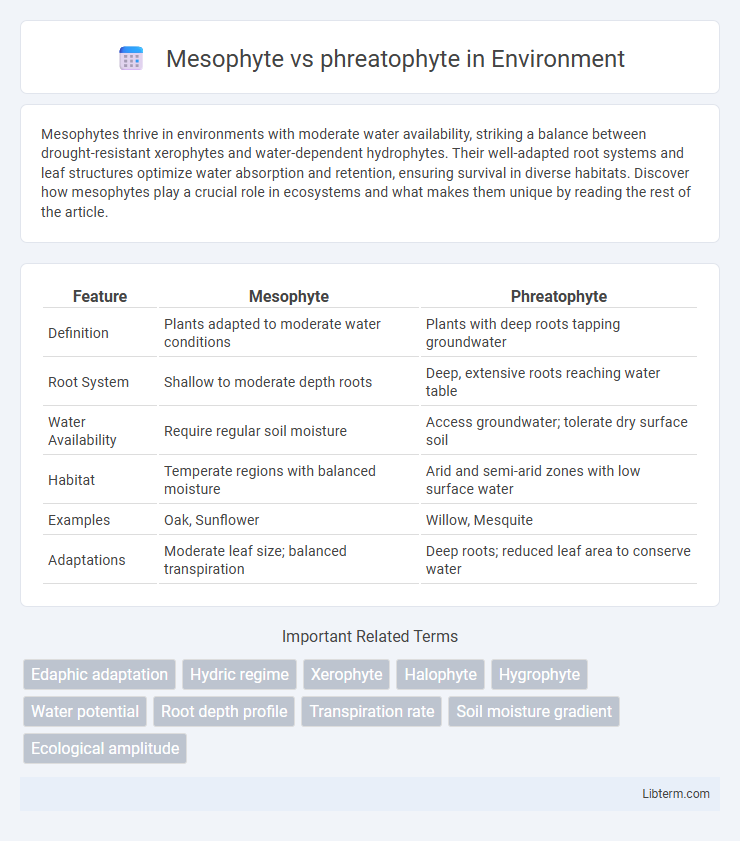Mesophytes thrive in environments with moderate water availability, striking a balance between drought-resistant xerophytes and water-dependent hydrophytes. Their well-adapted root systems and leaf structures optimize water absorption and retention, ensuring survival in diverse habitats. Discover how mesophytes play a crucial role in ecosystems and what makes them unique by reading the rest of the article.
Table of Comparison
| Feature | Mesophyte | Phreatophyte |
|---|---|---|
| Definition | Plants adapted to moderate water conditions | Plants with deep roots tapping groundwater |
| Root System | Shallow to moderate depth roots | Deep, extensive roots reaching water table |
| Water Availability | Require regular soil moisture | Access groundwater; tolerate dry surface soil |
| Habitat | Temperate regions with balanced moisture | Arid and semi-arid zones with low surface water |
| Examples | Oak, Sunflower | Willow, Mesquite |
| Adaptations | Moderate leaf size; balanced transpiration | Deep roots; reduced leaf area to conserve water |
Introduction to Mesophytes and Phreatophytes
Mesophytes are plants adapted to moderate water availability, thriving in environments with balanced soil moisture that supports typical plant growth without extreme drought or waterlogging. Phreatophytes are deep-rooted plants accessing groundwater through phreatic zones, enabling survival in arid or semi-arid regions by tapping into persistent subterranean water sources. Understanding the distinct water source adaptations in mesophytes and phreatophytes highlights their ecological roles in different hydrological settings.
Defining Mesophytes: Characteristics and Examples
Mesophytes are plants adapted to moderate environmental conditions with balanced water availability, neither too dry nor excessively wet, enabling efficient growth and physiological processes. Characterized by well-developed root systems, moderately thick cuticles, and stomata that regulate transpiration effectively, mesophytes include species such as oak trees, corn, and clover. These plants typically thrive in environments like grasslands, forests, and agricultural fields where soil moisture is stable but not waterlogged.
Understanding Phreatophytes: Key Traits and Species
Phreatophytes are deep-rooted plants that access groundwater by extending their roots into the water table, enabling survival in arid or drought-prone environments. Key traits of phreatophytes include extensive root systems, high water-use efficiency, and adaptation to fluctuating water tables, commonly found in species such as willows (Salix), cottonwoods (Populus), and mesquite (Prosopis). In contrast to mesophytes, which thrive in environments with moderate water availability, phreatophytes dominate ecosystems where surface water is scarce but subsurface water is accessible.
Water Requirements: Mesophytes vs Phreatophytes
Mesophytes require moderate water availability and typically thrive in environments with well-balanced soil moisture, avoiding extremes of dryness or saturation. Phreatophytes possess deep root systems that enable them to access groundwater, allowing survival in arid or drought-prone regions where surface moisture is insufficient. The water requirement of mesophytes depends on regular precipitation, whereas phreatophytes rely heavily on consistent groundwater sources to meet their hydration needs.
Root System Adaptations
Mesophytes possess moderately developed root systems adapted for environments with balanced water availability, enabling efficient uptake in well-drained soils. Phreatophytes exhibit highly specialized deep root systems that penetrate groundwater sources, allowing them to survive prolonged drought by accessing water tables far below the soil surface. These root adaptations reflect their ecological niches, with mesophytes thriving in mesic conditions and phreatophytes dominating arid or semi-arid habitats.
Ecological Roles and Habitats
Mesophytes thrive in environments with moderate water availability, such as forests and grasslands, playing crucial roles in nutrient cycling and providing habitat for diverse fauna. Phreatophytes are adapted to arid and semi-arid regions with deep groundwater access, stabilizing soil and preventing desertification by tapping into water tables through extensive root systems. Ecologically, mesophytes support balanced ecosystems with steady moisture, whereas phreatophytes sustain life and ecological functions in water-scarce habitats by accessing subsurface water resources.
Physiological Differences in Water Uptake
Mesophytes absorb water primarily through their shallow root systems, relying on regular soil moisture availability to maintain optimal physiological functions. Phreatophytes possess deep root systems that tap into groundwater sources, enabling sustained water uptake during drought conditions and minimizing water stress. These contrasting water uptake strategies reflect their adaptations to differing hydrological environments and influence stomatal regulation and transpiration rates.
Importance in Ecosystem Balance
Mesophytes and phreatophytes play crucial roles in maintaining ecosystem balance by regulating water availability and soil moisture. Mesophytes thrive in moderate moisture conditions, supporting diverse plant and animal communities, while phreatophytes access deep groundwater, helping stabilize water tables and prevent soil erosion. Their complementary water usage patterns promote sustainable nutrient cycling and habitat stability across varying environments.
Human Uses and Agricultural Significance
Mesophytes, with their moderate water requirements, are ideal for diverse agricultural crops such as wheat, corn, and rice, supporting food security and sustainable farming practices. Phreatophytes access deep groundwater through their extensive root systems, making them valuable for stabilizing groundwater levels and preventing soil erosion in arid and semi-arid regions. Human uses of phreatophytes include agroforestry and landscaping in drought-prone areas, enhancing ecosystem resilience and water management in agriculture.
Conclusion: Comparing Adaptations and Applications
Mesophytes exhibit moderate water requirements with adaptations such as well-developed root systems and balanced stomatal regulation, enabling growth in environments with regular but not excessive moisture. Phreatophytes possess deep root systems that access groundwater, demonstrating extreme drought resistance and suitability for arid or semi-arid regions with fluctuating water availability. Understanding these adaptations guides agricultural practices, ecological restoration, and water resource management by matching plant types to environment-specific hydrological conditions.
Mesophyte Infographic

 libterm.com
libterm.com